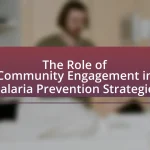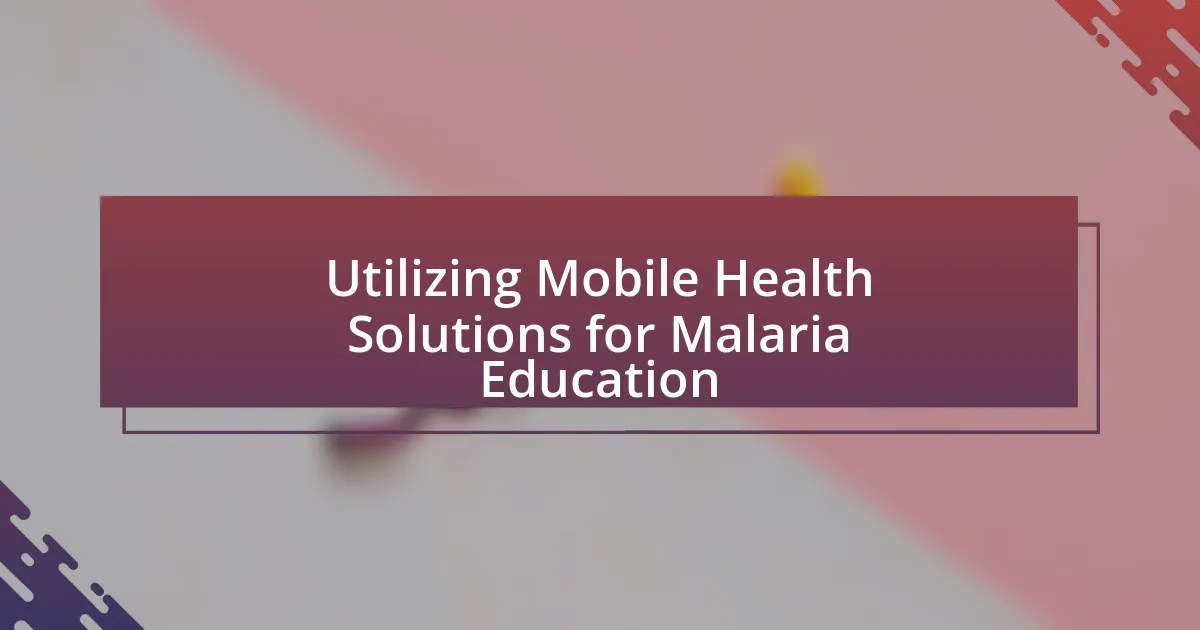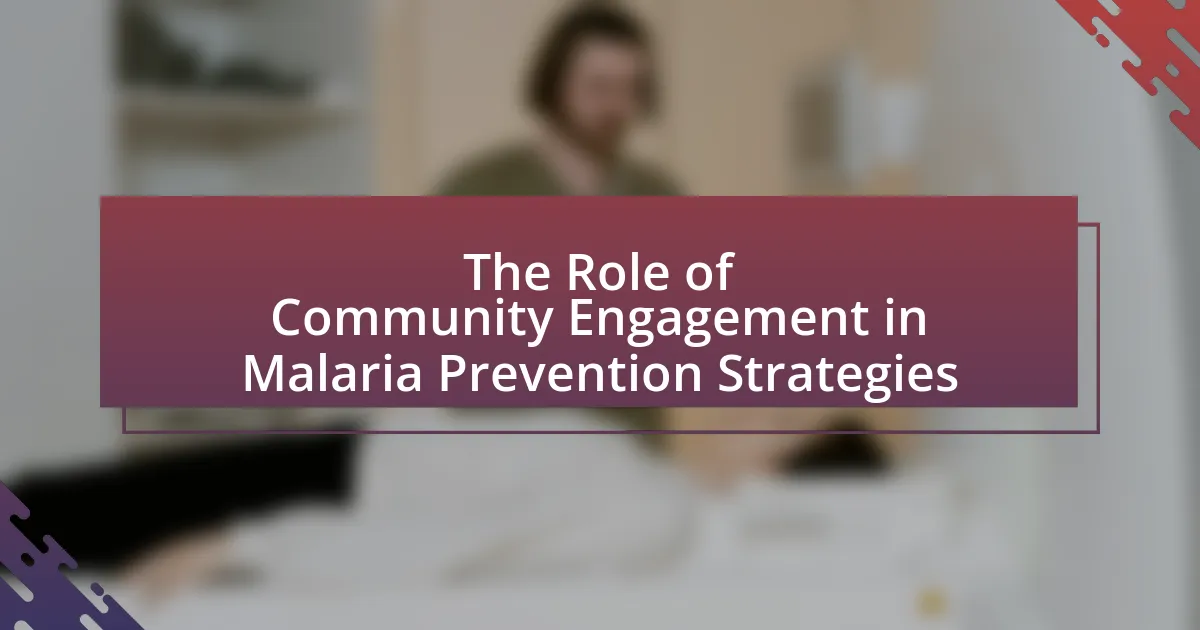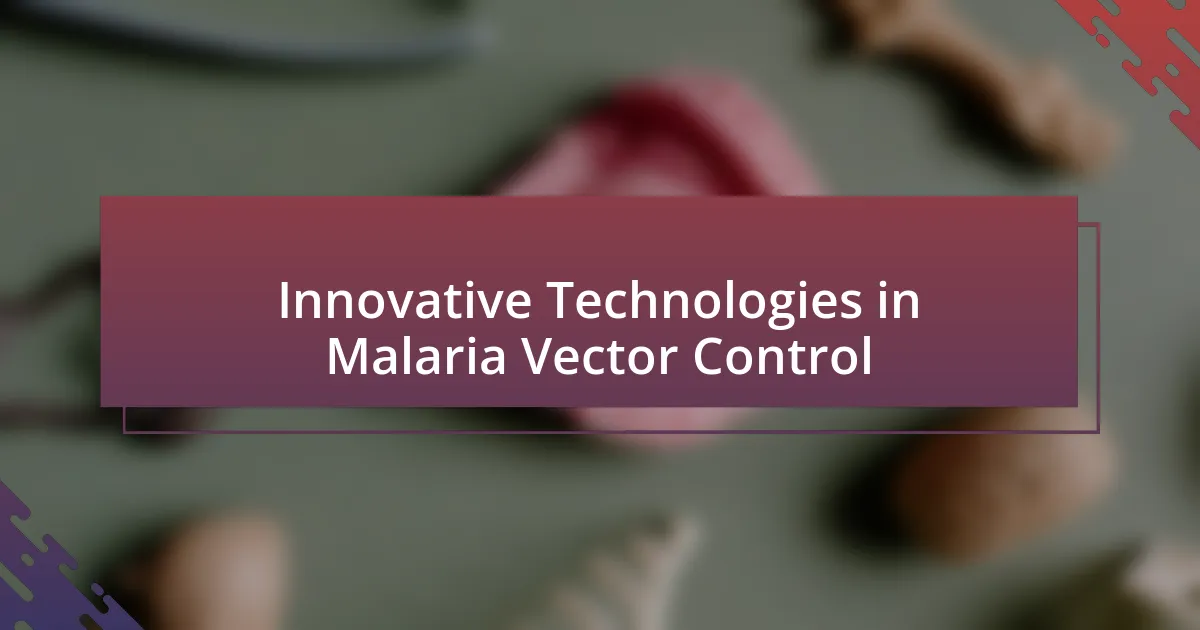The main entity of the article is the role of social media in raising awareness about malaria prevention. The article outlines how social media platforms such as Facebook, Twitter, and Instagram facilitate the rapid dissemination of information regarding malaria prevention, influencing public perception and engagement. It discusses effective strategies for malaria awareness campaigns, the impact of user demographics on engagement, and the advantages of social media over traditional media in health messaging. Additionally, the article addresses challenges such as misinformation and cultural differences, while highlighting best practices for organizations to enhance their social media efforts in promoting malaria prevention.

What is the role of social media in raising awareness about malaria prevention?
Social media plays a crucial role in raising awareness about malaria prevention by facilitating the rapid dissemination of information to a broad audience. Platforms like Facebook, Twitter, and Instagram enable health organizations and advocates to share educational content, prevention tips, and updates on malaria outbreaks, reaching millions of users instantly. For instance, campaigns such as the World Health Organization’s “Zero Malaria Starts with Me” initiative leverage social media to engage communities, promote preventive measures like the use of insecticide-treated nets, and encourage public participation in malaria control efforts. Studies have shown that social media can significantly increase knowledge and behavioral change regarding health issues, including malaria, by providing accessible and relatable content that resonates with diverse populations.
How does social media influence public perception of malaria?
Social media significantly influences public perception of malaria by disseminating information rapidly and shaping narratives around the disease. Platforms like Twitter and Facebook allow health organizations and advocates to share educational content, statistics, and personal stories, which can enhance awareness and understanding of malaria’s impact. For instance, campaigns that highlight the effectiveness of preventive measures, such as bed nets and vaccinations, can lead to increased community engagement and behavioral changes. Research indicates that social media can amplify public health messages, with studies showing that targeted campaigns can improve knowledge and attitudes towards malaria prevention, ultimately affecting health-seeking behaviors in affected populations.
What platforms are most effective for malaria awareness campaigns?
Social media platforms such as Facebook, Twitter, and Instagram are the most effective for malaria awareness campaigns. These platforms enable organizations to reach a wide audience quickly and engage users through interactive content. For instance, a study published in the Journal of Medical Internet Research found that social media campaigns significantly increased awareness and knowledge about malaria prevention methods among targeted populations. Additionally, Facebook’s targeted advertising features allow for demographic-specific outreach, enhancing the effectiveness of awareness efforts.
How do user demographics affect engagement with malaria prevention content?
User demographics significantly influence engagement with malaria prevention content, as factors such as age, education level, and geographic location determine how individuals interact with health information. For instance, younger audiences, particularly those aged 18-34, are more likely to engage with social media platforms where malaria prevention campaigns are prevalent, leading to higher interaction rates. Additionally, individuals with higher education levels tend to seek out and share health-related content more actively, as evidenced by a study published in the Journal of Health Communication, which found that educated users are more likely to engage with health information online. Geographic location also plays a crucial role; users in malaria-endemic regions may show greater engagement due to personal relevance, as highlighted by research from the World Health Organization, which indicates that localized content resonates more with affected populations.
Why is social media a vital tool for health communication?
Social media is a vital tool for health communication because it enables rapid dissemination of information to a wide audience. This platform allows health organizations to share critical updates, educational content, and preventive measures in real-time, which is essential for addressing public health issues like malaria. For instance, during malaria outbreaks, social media campaigns can reach millions, providing timely information on prevention strategies, symptoms, and treatment options. Research indicates that social media can increase awareness and knowledge about malaria, as evidenced by a study published in the Journal of Medical Internet Research, which found that targeted social media interventions significantly improved malaria knowledge among communities in endemic regions.
What advantages does social media offer over traditional media in health messaging?
Social media offers several advantages over traditional media in health messaging, including real-time communication, broader reach, and enhanced engagement. Real-time communication allows health organizations to disseminate urgent information quickly, which is crucial during health crises like malaria outbreaks. For instance, during the Ebola outbreak, social media platforms were used to share updates and preventive measures instantly, reaching millions within hours.
Additionally, social media has a broader reach, enabling messages to penetrate diverse demographics and geographic areas that traditional media may not effectively cover. According to a Pew Research Center study, 69% of adults in the U.S. use social media, providing a vast audience for health messaging.
Enhanced engagement is another significant advantage, as social media facilitates two-way communication, allowing users to ask questions, share experiences, and participate in discussions. This interactive nature fosters community support and encourages behavior change, which is essential in malaria prevention efforts. For example, campaigns on platforms like Facebook and Twitter have successfully mobilized communities to adopt preventive measures, such as using insecticide-treated nets.
How can social media facilitate community engagement in malaria prevention?
Social media can facilitate community engagement in malaria prevention by providing a platform for information sharing, awareness campaigns, and community mobilization. Through targeted posts, videos, and interactive content, social media enables health organizations and local communities to disseminate crucial information about malaria prevention methods, such as the use of insecticide-treated nets and indoor spraying. For instance, a study published in the Journal of Medical Internet Research found that social media campaigns significantly increased knowledge and preventive behaviors related to malaria in affected communities. Additionally, social media fosters dialogue among community members, allowing for the exchange of experiences and strategies, which enhances collective action against malaria.
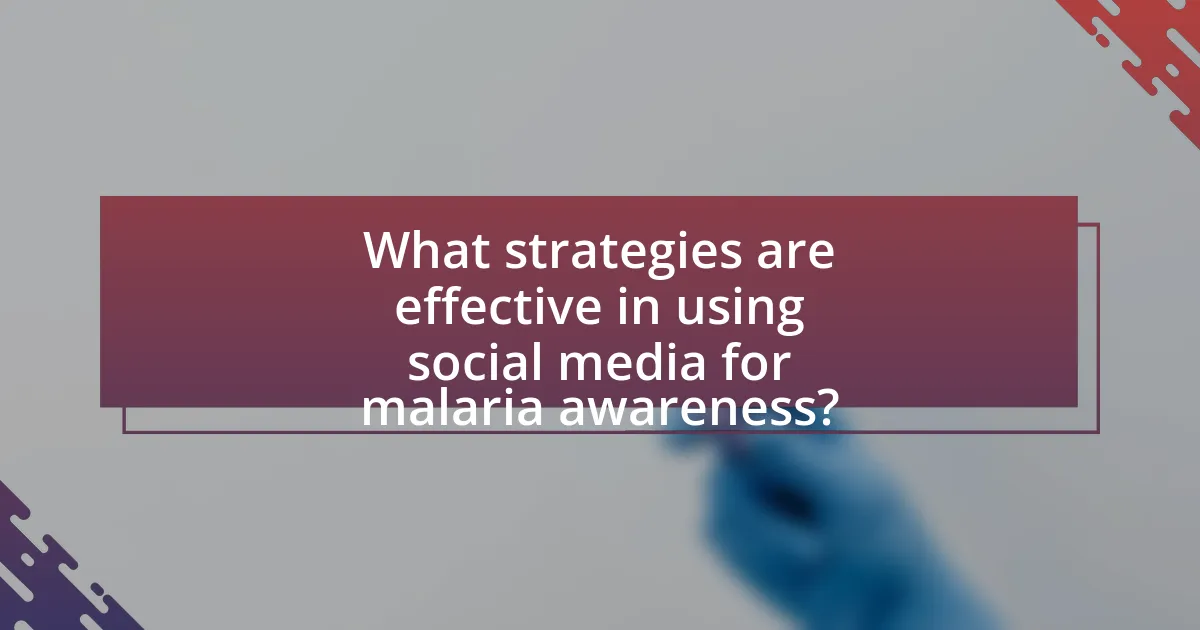
What strategies are effective in using social media for malaria awareness?
Effective strategies for using social media for malaria awareness include targeted campaigns, engaging visual content, and partnerships with influencers. Targeted campaigns utilize demographic data to reach specific audiences, ensuring that messages resonate with those most at risk. Engaging visual content, such as infographics and videos, can simplify complex information about malaria prevention and treatment, making it more accessible. Partnerships with influencers, particularly those in health and community sectors, can amplify messages and reach wider audiences, as seen in initiatives like the World Health Organization’s campaigns that leverage social media to educate communities. These strategies have proven effective in increasing awareness and promoting preventive measures against malaria.
How can organizations create impactful malaria prevention campaigns on social media?
Organizations can create impactful malaria prevention campaigns on social media by utilizing targeted messaging, engaging visuals, and interactive content. Targeted messaging ensures that the information resonates with specific demographics, increasing relevance and engagement. Engaging visuals, such as infographics and videos, can effectively convey complex information about malaria prevention methods, as studies show that visual content is more likely to be shared and remembered. Interactive content, like quizzes or polls, encourages user participation, fostering a sense of community and commitment to the cause. According to a report by the World Health Organization, social media campaigns that incorporate these elements have been shown to increase awareness and behavioral change regarding malaria prevention practices.
What types of content resonate most with audiences regarding malaria prevention?
Informative and engaging content types that resonate most with audiences regarding malaria prevention include infographics, personal stories, and educational videos. Infographics effectively convey statistics and prevention methods in a visually appealing manner, making complex information easily digestible. Personal stories from individuals affected by malaria create emotional connections and raise awareness about the disease’s impact. Educational videos provide visual demonstrations of prevention techniques, such as the use of bed nets and insect repellents, enhancing understanding and retention of information. Research indicates that visual content is more likely to be shared on social media, increasing its reach and effectiveness in raising awareness about malaria prevention.
How can storytelling enhance the effectiveness of malaria awareness messages?
Storytelling can enhance the effectiveness of malaria awareness messages by creating emotional connections that resonate with audiences. This approach allows individuals to relate to the experiences of others affected by malaria, making the information more memorable and impactful. Research indicates that narratives can increase engagement and retention of health information; for instance, a study published in the Journal of Health Communication found that stories significantly improved knowledge and attitudes toward health issues compared to traditional informational methods. By using storytelling, malaria awareness campaigns can effectively convey the urgency of prevention measures and motivate behavioral change among diverse populations.
What role do influencers play in malaria prevention campaigns on social media?
Influencers play a crucial role in malaria prevention campaigns on social media by leveraging their reach and credibility to disseminate information and raise awareness. They engage their followers through informative content, personal stories, and calls to action, effectively promoting preventive measures such as the use of insecticide-treated nets and the importance of seeking medical advice. Research indicates that campaigns featuring influencers can increase engagement rates significantly; for instance, a study published in the Journal of Global Health found that social media campaigns with influencer participation led to a 30% increase in awareness about malaria prevention methods among targeted demographics. This demonstrates that influencers can effectively mobilize their audiences to adopt healthier behaviors and support malaria prevention initiatives.
How can partnerships with influencers amplify malaria awareness efforts?
Partnerships with influencers can amplify malaria awareness efforts by leveraging their extensive reach and credibility to disseminate information effectively. Influencers possess established trust with their audiences, which can enhance the perceived importance of malaria prevention messages. For instance, a study published in the Journal of Medical Internet Research found that health-related messages shared by influencers led to increased engagement and knowledge retention among followers. By utilizing platforms where influencers are active, such as Instagram and TikTok, malaria awareness campaigns can reach diverse demographics, particularly younger audiences who may be more susceptible to malaria. This strategic collaboration not only raises awareness but also encourages behavioral change, as influencers can motivate their followers to adopt preventive measures against malaria.
What are the potential risks of using influencers in health campaigns?
Using influencers in health campaigns poses several potential risks, including the dissemination of misinformation, lack of expertise, and ethical concerns. Misinformation can arise when influencers share unverified health claims, leading to public confusion and potentially harmful behaviors. For instance, a study published in the Journal of Medical Internet Research found that social media platforms often amplify misleading health information, which can undermine public health efforts. Additionally, influencers may lack the necessary medical expertise to provide accurate health advice, which can result in followers making uninformed decisions regarding their health. Ethical concerns also emerge when influencers prioritize personal gain over public health, potentially compromising the integrity of health messages. These risks highlight the need for careful vetting and collaboration with qualified health professionals in influencer-led campaigns.
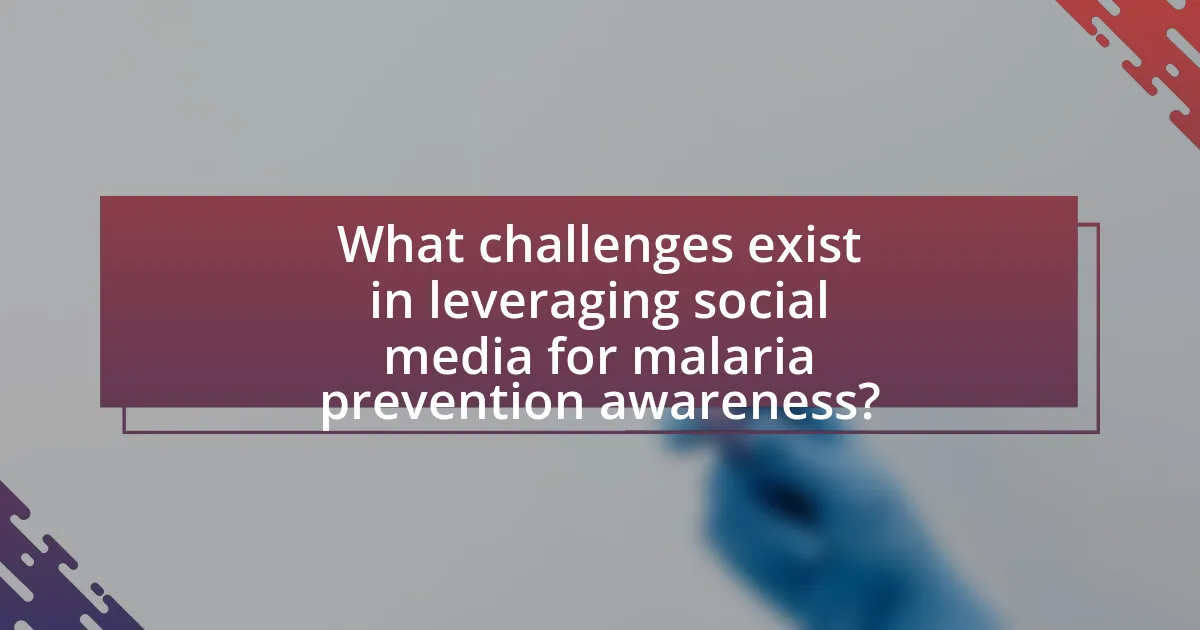
What challenges exist in leveraging social media for malaria prevention awareness?
Challenges in leveraging social media for malaria prevention awareness include misinformation, limited reach in rural areas, and varying levels of digital literacy among target populations. Misinformation can spread rapidly on social media, leading to confusion about malaria prevention methods; for instance, false claims about cures can undermine public health efforts. Additionally, many rural communities lack reliable internet access, which restricts the dissemination of accurate information. Furthermore, differing levels of digital literacy can hinder effective engagement, as some individuals may struggle to interpret health messages or navigate social media platforms. These factors collectively impede the effectiveness of social media campaigns aimed at raising awareness about malaria prevention.
What misinformation issues arise on social media regarding malaria?
Misinformation issues on social media regarding malaria include the spread of false cures, misconceptions about transmission, and exaggerated statistics about the disease’s prevalence. False cures, such as claims that certain herbal remedies can completely eliminate malaria, mislead individuals and can lead to dangerous health decisions. Misconceptions about transmission, such as the belief that malaria can be spread through casual contact, contribute to stigma and misunderstanding of the disease. Additionally, exaggerated statistics, often shared without context, can create unnecessary panic or complacency regarding malaria’s impact. These misinformation issues hinder effective public health messaging and can negatively affect malaria prevention efforts.
How can organizations combat misinformation about malaria on social media?
Organizations can combat misinformation about malaria on social media by implementing targeted educational campaigns that provide accurate information and engage with users directly. These campaigns should utilize clear, evidence-based messaging about malaria transmission, prevention, and treatment, leveraging infographics and videos to enhance understanding. For instance, the World Health Organization (WHO) has successfully used social media platforms to disseminate factual content, countering myths with data from peer-reviewed studies. Additionally, organizations can collaborate with social media platforms to flag false information and promote verified content, ensuring that users receive reliable information. Engaging local communities and influencers can also amplify the reach of accurate messaging, as seen in initiatives that have effectively reduced misinformation in various health contexts.
What strategies can be employed to ensure accurate messaging?
To ensure accurate messaging in the context of raising awareness about malaria prevention, employing fact-checking protocols is essential. Fact-checking involves verifying information against credible sources before dissemination, which helps prevent the spread of misinformation. For instance, organizations like the World Health Organization provide reliable data on malaria statistics and prevention methods, which can be referenced to ensure the accuracy of messages shared on social media platforms. Additionally, utilizing clear and concise language enhances understanding, while engaging with experts in the field can further validate the information being communicated.
How do cultural differences impact malaria prevention messaging on social media?
Cultural differences significantly impact malaria prevention messaging on social media by influencing the interpretation and reception of health information. For instance, cultural beliefs and practices shape how communities perceive malaria, affecting their willingness to adopt preventive measures. In regions where traditional medicine is prevalent, social media messages emphasizing biomedical approaches may be met with skepticism, as seen in studies indicating that culturally tailored messages improve engagement and compliance. Furthermore, language and communication styles vary across cultures, necessitating localized content to enhance understanding and relatability. Research by the World Health Organization highlights that culturally relevant messaging increases the effectiveness of health campaigns, demonstrating that adapting content to cultural contexts can lead to higher rates of malaria prevention adherence.
What considerations should be made for culturally sensitive content?
Culturally sensitive content must respect and reflect the values, beliefs, and practices of diverse communities. This involves understanding cultural norms, avoiding stereotypes, and ensuring accurate representation of different groups. For instance, research indicates that culturally tailored health messages are more effective; a study published in the American Journal of Public Health found that culturally relevant interventions significantly improved health outcomes in minority populations. Additionally, engaging local voices and stakeholders in content creation fosters authenticity and trust, which are crucial for effective communication in public health campaigns, particularly in malaria prevention efforts.
How can social media campaigns be tailored to diverse audiences?
Social media campaigns can be tailored to diverse audiences by segmenting the target demographic based on factors such as age, culture, language, and socio-economic status. This segmentation allows for the creation of customized content that resonates with each group, ensuring that messages about malaria prevention are relevant and engaging. For instance, using local languages and culturally relevant imagery can enhance understanding and relatability, as evidenced by a study published in the Journal of Health Communication, which found that culturally tailored health messages significantly improved engagement and knowledge retention among diverse populations. Additionally, leveraging data analytics to monitor audience interactions can help refine strategies and optimize content delivery, making campaigns more effective in raising awareness about malaria prevention across varied communities.
What best practices should organizations follow when using social media for malaria awareness?
Organizations should prioritize clear messaging, audience engagement, and data-driven strategies when using social media for malaria awareness. Clear messaging ensures that information about malaria prevention, symptoms, and treatment is easily understood and accessible, which is crucial given that malaria affects millions globally. Engaging with the audience through interactive content, such as quizzes or live Q&A sessions, fosters community involvement and encourages sharing of information. Data-driven strategies, including analyzing engagement metrics and demographic insights, help organizations tailor their content to effectively reach and resonate with specific audiences. For instance, the World Health Organization emphasizes the importance of targeted communication to enhance public understanding and response to malaria prevention efforts.
How can organizations measure the effectiveness of their social media campaigns?
Organizations can measure the effectiveness of their social media campaigns by analyzing key performance indicators (KPIs) such as engagement rates, reach, conversion rates, and return on investment (ROI). Engagement rates, which include likes, shares, and comments, indicate how well the content resonates with the audience. Reach measures the total number of unique users who see the content, providing insight into the campaign’s visibility. Conversion rates track the percentage of users who take a desired action, such as signing up for a newsletter or donating, reflecting the campaign’s impact on behavior. ROI quantifies the financial return relative to the campaign’s cost, allowing organizations to assess overall effectiveness. According to a study by Hootsuite, campaigns that effectively utilize these metrics can improve engagement by up to 50%, demonstrating the importance of data-driven analysis in social media strategy.
What tools are available for analyzing social media engagement in health campaigns?
Tools available for analyzing social media engagement in health campaigns include Hootsuite, Sprout Social, and Google Analytics. Hootsuite allows users to track engagement metrics across multiple platforms, providing insights into audience interactions and content performance. Sprout Social offers advanced analytics features, enabling detailed reporting on engagement trends and audience demographics. Google Analytics can track referral traffic from social media to health campaign websites, helping to measure the effectiveness of social media efforts in driving user engagement. These tools are widely used in public health campaigns to assess the impact of social media strategies on audience awareness and behavior.


